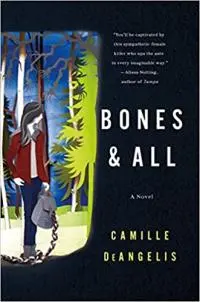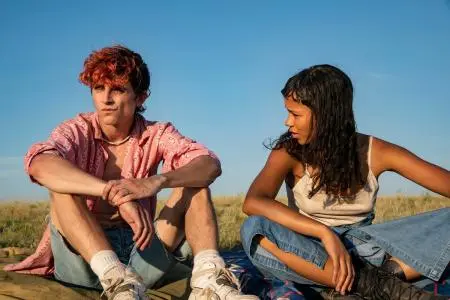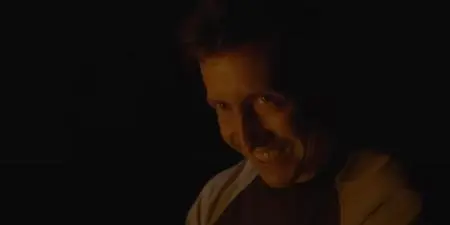SPOILERS AHEAD
It’s been said plenty of times before, but it’s worth repeating: the best cinematic adaptations of novels stay mostly true to their source material while at the same time carving out their own paths. Rigidly faithful adaptations can be great films (think Rosemary’s Baby, though feel free not to think about Roman Polanski, ever), but by and large these movies can feel stale for anyone already familiar with the book.
On the other hand, if a film strays too far from its origins, it’s hard to even see it as a version of its predecessor at all (think The Lawnmower Man, an in-name-only adaptation of a Stephen King story, so far removed from his work the author successfully sued to have his name removed from the film’s promotional materials).
Bones and All, the new film from director Luca Guadagnino and screenwriter David Kajganich, based on the novel of the same name by Camille DeAngelis, manages to stay in this precious middle ground, mostly sticking to its source in terms of plot, but straying just far enough not to completely alienate itself from said source. However, the changes made from page to screen are significant and meaningful, and they ultimately make better use of the novel’s characters and situations.
The Book
The time is 2007. In first person narration, our protagonist Maren, a shy and bookish teenage girl, recounts her experiences as an “eater,” a person who is compelled to gobble up anyone who shows her affection “like an ogre in a fairytale,” as the author herself puts it in an interview with the website Responsible Eating And Living. The story begins on Maren’s 16th birthday, a lovely celebration between mother and daughter and an event that makes the main character feel “normal.”
 The next morning, she discovers that her mother Janelle has abandoned her, after years of cleaning up her gruesome eating habits and moving her from state to state to ensure her safety — an act of sacrifice first implemented when, as a baby, Maren devoured her overly-attached babysitter. Dejected and in need of answers, Maren hits the road to locate her long-lost father, whom she learns is named Francis Yearly from her own birth certificate, a parting gift from Maren’s mother; she also strongly suspects her flesh-eating is a paternal genetic trait.
The next morning, she discovers that her mother Janelle has abandoned her, after years of cleaning up her gruesome eating habits and moving her from state to state to ensure her safety — an act of sacrifice first implemented when, as a baby, Maren devoured her overly-attached babysitter. Dejected and in need of answers, Maren hits the road to locate her long-lost father, whom she learns is named Francis Yearly from her own birth certificate, a parting gift from Maren’s mother; she also strongly suspects her flesh-eating is a paternal genetic trait.
While on the road, Maren meets and befriends an older man named Sully, another eater who schools her on the ways of being a wayward, cannibalistic "creature." He wants to steer Maren away from her quest to find her father, but she continues on anyway, and eventually begins traveling with Lee, another drifting eater closer to her own age. They fall in love and they feed together, but while Maren has a deepening sense of guilt over all the bloodshed and devouring of flesh, Lee sees it as a grisly but necessary facet of their survival, and feels no remorse.
Maren ultimately finds her dad locked away in a mental institution. As she suspected, he is indeed an eater too, and he exiled himself before Maren was born to ensure she and her mother stayed safe. The years inside have rendered him a husk of his former self, and at some point during his confinement, he ate his own hand to satiate his breed’s particular hunger. Devastated, Maren and Lee try to move on with their romance as best they can, until Sully re-enters the picture with a deranged objective: it turns out he’s been hunting Maren down for most of her life, because he's actually Maren’s paternal grandfather, and he believes any offspring — or offspring of offspring for that matter — are “mistakes” that must be fixed by gobbling them up, like Saturn devouring his young.
Sully twice comes after Maren, and the second time, toward the novel’s end, he’s dispatched rather easily by Lee, after which Maren gives up on her dreams of a normal life and gives in to her “monstrousness,” first by eating Lee, the man she loves, and then actively preying on students at the University of Wisconsin-Madison. The End.
I favorably reviewed Bones & All for LitReactor back when the novel was published in 2015. There I noted that in the acknowledgements, author DeAngelis stated her novel was essentially a vegan treatise against any and all flesh-eating, a point she has reasserted many times in interviews, including in the aforementioned piece for Responsible Eating And Living, as well as an article published on Chic Vegan. In the latter, DeAngelis states:
Most humans are (or used to be) flesh eaters, and as consumers of animal flesh, we are predators even though we probably didn’t slaughter our dinner ourselves. I wrote Bones & All to get readers thinking, ‘Am I okay with being a predator? Is that really who I want to be?’
Of course, many would argue that eating animals is a much lesser sin than eating other humans, that the latter is murder while the former is sustenance. But who are we to say which lives matter and which lives do not...? We must file both cannibalism and carnivorism under Just because we can, doesn’t mean we should.
Based on this comment, we can assume that Maren’s decision to continue feeding is the ultimate act of monstrousness. This seems a harsh conclusion, given that DeAngelis shows us Maren cannot help consuming flesh, even when she is a baby and doesn’t fully possess the cognitive ability to discern right from wrong, “good” from “evil.” And when she is old enough to know the difference, she tries so hard not to do "the bad thing," but when she's put in positions she can't fully escape, the eater in her takes control, "morals" be damned. It’s a genuine compulsion, genetically passed down to her from her father, something she absolutely cannot control unless she wishes to spend the rest of her either life completely alone, completely insane, or both.
It could be argued that Maren’s predatory behavior at novel’s end is monstrous, given that there’s an ethical way to eat (sniff out someone who’s about to die and chew them up once they’ve expired), but even this is damnable in the eyes of DeAngelis, who insists it is flesh-eating alone that is immoral. It seems unfair to condemn a character for a genetic predisposition they can’t change and for choosing survival over isolation, insanity, or even death, and while overall the novel is well-written and engaging, its underlying thematic statement feels too oppressive to give it an enthusiastic thumbs up, as I did back in 2015. I’m more inclined to favor the works of Clive Barker — particularly Nightbreed — and James Whale, director of the monster-friendly 1931 adaptation of Frankenstein and its sequel Bride of Frankenstein. These creators see “monstrousness” not as innate, but rather as a condition imposed upon those who walk against the grain of the supposedly squeaky-clean status quo.
The Film

Barker and Whale, two queer icons of horror, are pertinent figures in the discussion of this adaptation. Director Guadagnino and screenwriter Kajganich are both openly gay men, and much like Barker and Whale, their work demonstrates a clear “sympathy for the devil,” so to speak. Unlike DeAngelis, they don’t view eaters as condemnable; they are, plainly speaking, “born this way.”
The film, which moves the action to the notoriously repressive 1980s, directly correlates eating with queerness, showing Maren (played brilliantly by Taylor Russell) staring intimately into the eyes of her friend just before wrapping her mouth around the girl’s finger and chomping down. Likewise, Lee (the ever-engaging Timothée Chalamet) lures a cruel but likely closeted carnie out into a row of isolated cornfields by flirting and ultimately having sex with him, right before slitting the man’s throat - an act that, much like her literary counterpart, horrifies Maren, but here it eventually disturbs Lee as well.
This same-sex dalliance isn’t meant to suggest queer people are monsters; rather, it serves as a metaphor for the marginalization and self-loathing suffered by such societal outcasts. Lee claims to be comfortable with who he is, but as his romance with Maren blossoms and his protective walls begin to erode, it becomes clear he carries significant shame not only for his eating but also for his flamboyant persona — in one particular scene, his sister tells him his flashy patterned shirt makes him look like a “f*ggot,” which prompts him to immediately remove the garment.
Fittingly, the source of Lee’s shame comes not only from the negative societal stigma of queerness, but also from his father, an abusive alcoholic and fellow eater who bit into his son’s chest during a drunken rage, leaving a mouth-shaped scar just below Lee’s left nipple. Much like in the aforementioned myth of Saturn, Lee (Zeus) retaliates and defeats the father by eating him up, suggesting he is the superior man, although Lee bites the cruel carnie in the exact same place as his father bit him, indicating the father actually transferred a predilection toward guilt, shame, and violence to the son, and thus, they are not so different in the end. It is only by thoroughly embracing his softer, more vulnerable (read: “feminine”) side — ultimately a necessity for the survival of his relationship with Maren — that Lee truly frees himself from the shadow of his father.
For Maren’s part, she too must find her own path and embrace herself outside the mold set for her by her parents. Kajganich and Guadagnino switch her mother and father, so that it is Frank (André Holland) who abandons Maren on her birthday (here the 18th, rather than the 16th) and Janelle (Chloë Sevigny) who ends up exiled in a mental institution, denying herself the genetic need to eat. This change not only echos the prevalence of real-life dead-beat dads who walk out on their kids, it forges an even deeper bond between Maren and Lee, and it further reinforces the film’s underlying critique of a patriarchal society that rejects queerness (like Janelle in the novel, Frank refers to Maren’s sensual finger-chomping as “the bad thing").
Furthermore, when Maren finds Janelle in the hospital, she has not merely eaten one hand, but both, and most of her arms as well; she, like Lee’s father, also attempts to eat her child, i.e., to destroy that which she loathes about herself. In this way she appears like a crazed Venus de Milo, a perversion of the goddess and her Greek counterpart Aphrodite, who represents sensuality, sexuality, and passion, among other qualities typically associated with female attributes. As in the novel, Maren becomes convinced she is nothing but a monster following this run-in with her institutionalized parent and runs from her relationship with Lee. Her journey then becomes one of realizing that her love for Lee, and his love for her, ultimately keep them safe from “monstrousness,” from turning into the snarling, deranged things of repression their parents became.

Yet this isn’t entirely a “love conquers all” narrative. Yes, embracing each other is important, but if the couple makes one mistake, it’s not fully embracing their inner "eater" selves, until it’s too late. The couple decides to try and live a “normal,” life; they settle down in an apartment together, they go to school, they cook nice, non-cannibalistic dinners and talk to Lee’s sister on the phone. But then Sully (Mark Rylance, delivering a truly beguiling performance) shows back up. While the character is a Saturn figure in DeAngelis’s work, obsessed with snuffing out his offspring, in the film he is no longer definitively Maren’s grandpa (though that fact is left open for consideration). He is instead interested in Maren as a romantic and sexual partner, though one who isn't allowed to show agency of any kind or else face his wrath. He is yet another cancerous extension of the patriarchy, effectively an incel who has isolated himself not only from the larger society, but from his own people as well, as he waits for the “perfect mate.”
In this way, Sully encompasses the final point of a triangle representing the different extremes of monstrous behavior: the parental figures, especially Lee’s father and Maren’s mother, are monster-like through repression, becoming predators, or would-be eaters, of that which they hate most in themselves; Lee’s initial cavalier attitude toward murder makes him discompassionate and thus full-on predatory in the way DeAngelis describes — someone who must feed and doesn’t care that he has to hurt someone else to do it; and Sully, who, like Lee, unapologetically embraces who he is, but becomes a bloodthirsty sexual predator precisely because he has kept himself disconnected from all other human interaction, eater or otherwise.
Kajganich and Guadagnino seem to argue that balance (or perhaps self-actualization) comes from positioning oneself away from the extremes. They achieve this through the film’s climax, which also has Maren consuming Lee, though not because she’s simply decided to lean-in to monstrousness, but rather because he has been mortally wounded by Sully during the characters’ final, violent confrontation, and because he begs her to do it, to eat him “bones and all.” This is a rare moment in which a character uttering the movie’s title actually works, since it harkens back to a conversation Lee and Maren have toward the middle of the narrative with two ironically unsavory figures, eater Jake and his “normal” eater-groupie Brad (played by Michael Stuhlbarg and, weirdly, director David Gordon Green, respectively). In the novel, the act of eating is more fantastical, a minutes-quick process that leaves no trace of the person behind, save a puddle of blood. The film’s depiction of eating is a bit more grounded in reality, and as such, the bones and other bits of viscera and gore don’t go into the eater’s belly. But Jake claims to have eaten every last morsel of multiple people, including the bones, and that this act is the apex of an eater’s life, something sacred and profound.
The filmmakers ultimately don’t show the audience whether Maren in fact eats Lee “bones and all,” preferring to end the narrative with a shot of the couple naked in a field somewhere in Nebraska, a flashback to their most intimate and perfect moment, before they decided to deny who they were and live like everyone else. But it makes thematic sense if Maren does commit this sacred act with the man she loves, because it suggests in consuming him whole, she is re-embracing herself, taking in Lee’s best qualities and thus turning away from denial and repression and totally accepting who she is. The last shot of the film reinforces this idea of reunification: by returning to this moment of serenity and balance, the filmmakers seem to be saying that, while the journey was heartbreaking, Maren will come out a more actualized person, someone who carries this passionate romance and all it symbolizes with her forever.
Moreover, this conclusion firmly solidifies the film as not only a queer parable, but a narrative with which any societal misfit can identify. IndieWire writer Kate Ebland, in an interview with Kajganich, notes the more universal implications of DeAngelis’s work (when you ignore its ultimately didactic status and the fact we’re meant to condemn Maren’s actions by the novel's end, of course):
DeAngelis’ book really fit that bill as a genre outing that’s also a coming-of-age tale, a deep romance, and an exploration of what it means to accept yourself in a world hellbent on rejecting you.
‘Everybody’s gone through experiences where we’ve been pushed to the side, particularly people who have the monikers of being “other” in our society, whatever that means, and that’s a long list of things that could mean,’ the writer said. ‘What I really loved about the book was that it seemed to speak to all of them under the metaphoric heading of “cannibalism.”’
Later in the piece, Kajganich acknowledges that there are indeed parallels to queerness in Bones and All, but he also further reinforces the notion that it is not the only pertinent aspect or reading to consider:
There are probably a lot of people in a lot of categories of pain or personal fear and anxiety, that could unpack that metaphor in a different way... I didn’t want to be too prescriptive about it, because I do think it could have to do with gender, it could have to do with orientation, it could have to do with race, it could have to do with where you sit on the economic spectrum. It could have to do with where you sit on any number of spectrums or continuum. And I just thought, ‘Why push it into any one or several literal directions when it really stands up on its own?’
And this is precisely why the film adaptation of DeAngelis’s book works so much better than the original novel. It ultimately adopts a “monster-friendly” stance by linking metaphorical cannibalism to marginalization of any kind, queer or otherwise. It isn’t simply a work of fiction pushing a very specific set of beliefs that, if you find yourself swayed by the argument, forces you to reject the main character for something outside of her control. The film really only seems interested in promoting one agenda: love, even when it’s messy, even when it’s hard, even when it means acknowledging aspects of yourself you might not like (at least at first). It becomes, in this way, a timeless and multi-faceted narrative that will surely continue to grip audiences and spark conversation for years to come.
Get Bones and All at Bookshop or Amazon

Meet the best editors in the industry on Reedsy
Sign up to request quotes from editors who shape bestsellers.

About the author
Christopher Shultz writes plays and fiction. His works have appeared at The Inkwell Theatre's Playwrights' Night, and in Pseudopod, Unnerving Magazine, Apex Magazine, freeze frame flash fiction and Grievous Angel, among other places. He has also contributed columns on books and film at LitReactor, The Cinematropolis, and Tor.com. Christopher currently lives in Oklahoma City. More info at christophershultz.com







